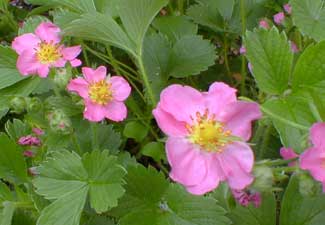
'Pink Panda'
Ornamental Strawberry
"And you may love the strawberry-flower,
And love the strawberry in its bower."
-William Wordworth,
1832
1832
Fragaria chiloensis 'Pink Panda' is a sun-loving ornamental strawberry vine which grows fairly fast, but not invasively, into a colorful groundcover peppered with one-inch bright pink flowers with yellow centers from spring right on through to November.
In our temperate climate it will even produce a few blooms in December & January despite that the greenery is getting winter-worn. It also does nicely in a mixed hanging basket or in strawberry planter urns or in window boxes.
New plants spring up from above-ground creeping stolons, & the direction of the spread can be controlled by lifting & moving these stolons where a gardener wants them, or clipping them off for a bushier central plant that can mound as high as a foot & be trained as more of a bush in lieu of a creeping grandcover vine.
It prefers temperate seasons & is a moribund evergreen in winter, thus has year-round groundcover value, though it will die back much more in colder climates.
The natural wild F. chiloensis has white blooms, not pink, & 'Pink Panda' with bright pink blooms is hybridized with Potentilla palustris, hence occasionally called "Strawberry Potentilla." Another commonly offered variety of ornamental strawberry is named 'Lipstick' with a slightly different hybrid history, Fragaria ananassa x P. palustris.
'Pink Panda' was developed by "Blooms of Bressingham" in England. It still looks entirely like a strawberry rather than a potentilla, but with more vigorous evergreen capacity & deeply colored blossoms. It has a weakened smaller fruit, since it gives more of its energy to producing the blooms.
Less than half the blooms produce tiny bright-red strawberry fruits, but that's still a considerable number of fruits. These are sweet & tasty though too small to make much of a harvest.
If fruits are permitted to ripen the blooms may become fewer, but it's worth it for the occasional strawberry to pop in one's mouth while gardening. Pick them as quicky as possible, so that the plant continues in bloom deep into autumn or even into winter. The far fewer "out of season" blooms do not produce fruit of course.
Though the vines spread fastest in warm weather, the flowers last longer with a little shade, especially in the hottest afternoon. It likes moist well drained ordinary soil, but is highly adaptable, & after its first year is drought tolerant, though of course leafier & more flowery with adequate waterings.